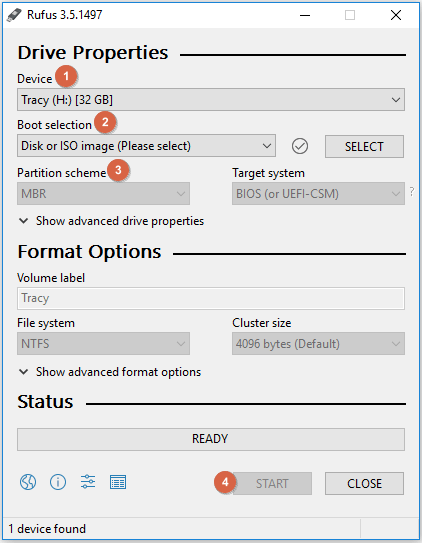

It's a bit more tedious and slow, but if you have a large wall, it will leave you with a similarly large bookshelf, that you can later use to put other books. On the other hand, ISO mode is akin to first providing you with a bookshelf, which is tailored to the space you have against a wall of your choosing, and then cloning books one by one into it. For some cases, cloning the bookshelf in one go may be the best option, but in others, you may find that this bookshelf is locked with a key that you don't have, and it has to sit right in the middle of your living room, which prevents you from installing a couch, or something else.
#Rufus iso image full#
If you want a quick analogy, you can consider that DD mode is similar to cloning a whole bookshelf, full of books, into your living room. But as I pointed above, ISO mode also ensures that you can always access the full content of your USB.
#Rufus iso image windows#
One of the drawback this has is that the boot loading and later process of the media has to be able to handle a Windows file system (usually FAT32, but it could be NTFS or exFAT), which may come with some limitations, but this is usually not an issue for something like an installation media.Īlso, if you have a lot of small files the copy process in ISO mode can be a lot slower than the DD mode copy process. On the other hand what ISO mode does is partition and format the USB in a way that Windows can always understand (and using the whole capacity of the drive), and then copy each individual file and directory from the ISO image onto the newly created file system.
#Rufus iso image trial#
For instance, if you DD copy a 4GB image onto a 16GB USB, then even if you can access your drive from Windows, you will only ever be able to access 4GB of your drive, and not 16.įinally, the choice between DD and ISO only applies to ISOHybrid images (not all ISOs are ISOHybrid!), which is a somewhat brittle hack that tries to make optical disc filesystems (ISO9660 or UDF) something that they were never designed to do (which essentially boils down to making it look like a completely different file system, along with constructs, such as a partition table, that are not meant to apply to optical media), so it takes A LOT of trial and error to get something that kind of works, but has some limits. Also, even if you are able to access the content, you will find that the available size you have is a lot less than the total size of your USB. So if you want to modify some settings, or want to access the doc, or, say, copy the firmware for your Wifi card onto the USB, you may not be able to do so. But this can also be one of the drawbacks, as it means you will usually find that you cannot access the content of your USB any longer after it has been created. One advantage is that it doesn't require partitioning or formatting, and it can create USB drives with file systems that Windows is unable to handle on its own (such as ext# or anything *BSD). That's all DD does, and it usually ensures that you get an exact clone of the image or device the maintainer of the distro created. onto the USB, starting at the first byte of the first sector, and continue to copy bytes until the data from the image is exhausted.

then what Rufus or any other DD application will do is copy 33 ED 90 90. Basically, this flat copies the image byte by byte onto the USB, so if you look at the image in hex and see it starts with something like 33 ED 90 90. I confirmed, by performing an internet search, that these values match the ones from the official image.įor an Arch Linux ISO, could you please explain the overall difference, when creating a USB Flash Drive, between Rufus' ISO Image mode and it's DD Image (disk image) mode? I am trying to understand what steps Rufus goes through, depending on which mode is selected, and how that affects the outcome.ĭD is an exact clone of the image onto the USB. If using an ISO image, I clicked on the # button (at the bottom of the Rufus interface), to compute the MD5, SHA1 and SHA256 checksums, which are therefore present in the log I copied.I also tried one or more of the following:.




 0 kommentar(er)
0 kommentar(er)
